Privlaka may refer to:
- Privlaka, Vukovar-Syrmia County, Croatia
- Privlaka, Zadar County, Croatia
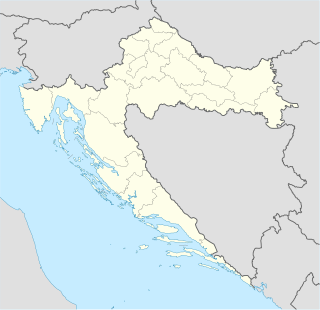
Privlaka is a municipality in Zadar County in Croatia. According to the 2011 census, there are 2,253 inhabitants in the area, 98% of whom are Croats.
Privlaka may refer to:

Privlaka is a municipality in Zadar County in Croatia. According to the 2011 census, there are 2,253 inhabitants in the area, 98% of whom are Croats.
| This disambiguation page lists articles about distinct geographical locations with the same name. If an internal link led you here, you may wish to change the link to point directly to the intended article. |

Croatia, officially the Republic of Croatia, is a country at the crossroads of Central and Southeast Europe, on the Adriatic Sea. It borders Slovenia to the northwest, Hungary to the northeast, Serbia to the east, Bosnia and Herzegovina, and Montenegro to the southeast, sharing a maritime border with Italy. Its capital, Zagreb, forms one of the country's primary subdivisions, along with twenty counties. Croatia has an area of 56,594 square kilometres and a population of 4.28 million, most of whom are Roman Catholics.
The politics of Croatia are defined by a parliamentary, representative democratic republic framework, where the Prime Minister of Croatia is the head of government in a multi-party system. Executive power is exercised by the Government and the President of Croatia. Legislative power is vested in the Croatian Parliament. The Judiciary is independent of the executive and the legislature. The parliament adopted the current Constitution of Croatia on 22 December 1990 and decided to declare independence from Yugoslavia on 25 May 1991. The Constitutional Decision on the Sovereignty and Independence of the Republic of Croatia came into effect on 8 October 1991. The constitution has since been amended several times. The first modern parties in the country developed in the middle of the 19th century, and their agenda and appeal changed, reflecting major social changes, such as the breakup of Austria-Hungary, the Kingdom of Serbs, Croats and Slovenes, dictatorship and social upheavals in the kingdom, World War II, the establishment of Communist rule and the breakup of the SFR Yugoslavia.

Dalmatia is one of the four historical regions of Croatia, alongside Croatia proper, Slavonia, and Istria.
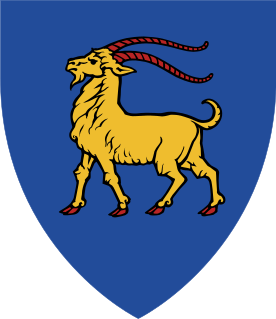
Istria, formerly Histria (Latin), Ίστρια, is the largest peninsula in the Adriatic Sea. The peninsula is located at the head of the Adriatic between the Gulf of Trieste and the Kvarner Gulf. It is shared by three countries: Croatia, Slovenia, and Italy. Croatia encapsulates most of the Istrian peninsula with its Istria County.
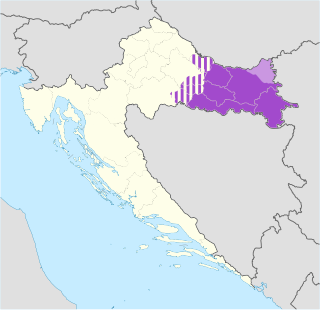
Slavonia is, with Dalmatia, Croatia proper and Istria, one of the four historical regions of Croatia. Taking up the east of the country, it roughly corresponds with five Croatian counties: Brod-Posavina, Osijek-Baranja, Požega-Slavonia, Virovitica-Podravina and Vukovar-Srijem, although the territory of the counties includes Baranya, and the definition of the western extent of Slavonia as a region varies. The counties cover 12,556 square kilometres or 22.2% of Croatia, inhabited by 806,192—18.8% of Croatia's population. The largest city in the region is Osijek, followed by Slavonski Brod and Vinkovci.
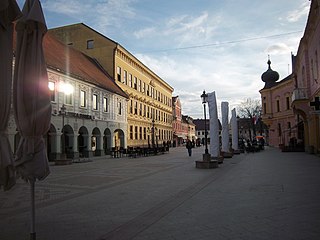
Vinkovci is a city in Slavonia, in the Vukovar-Srijem County in eastern Croatia. In the 2011 census, the total population of the city was 35,312, making it the largest town of the county. Surrounded by many large villages, it is a local transport hub, particularly because of its railways.

Zagreb County is a county in central Croatia. It surrounds – but does not contain – the nation's capital Zagreb, which is a separate territorial unit. For that reason, it is often nicknamed "Zagreb ring". According to the 2011 census, the county has 317,606 inhabitants.

Zadar County is a county in Croatia, it encompasses northern Dalmatia and southeastern Lika. Its center is the city of Zadar.
Syrmia is a fertile region of the Pannonian Plain in Europe, which lies between the Danube and Sava rivers. The majority of Syrmia is located in the Srem and South Bačka districts of the Autonomous Province of Vojvodina in Serbia. A smaller area around Novi Beograd, Zemun, and Surčin belongs to the City of Belgrade. The remaining part of Syrmia is divided between multiple municipalities in Serbia and Vukovar-Srijem County in Croatia.

Primorje-Gorski Kotar County is a county in western Croatia that includes the Bay of Kvarner, the surrounding Northern Croatian Littoral, and the mountainous region of Gorski kotar. Its center is Rijeka. The county's population was 315,000 in the 2018 census.

Osijek-Baranja County is a county in Croatia, located in northeastern Slavonia and Baranja. Its center is Osijek; other cities include Đakovo, Našice, Valpovo, Belišće, Beli Manastir.

Croatian Radiotelevision is a Croatian public broadcasting company. It operates several radio and television channels, over a domestic transmitter network as well as satellite. In 2014, more than 85% of HRT's revenue came from broadcast user fees with each household in Croatia required to pay 79 HRK (~€10) per month for a single television set, with the remainder being made up from advertising. Croatian Radiotelevision has three organizational units, three sister companies - the Croatian Radio, the Croatian Television and Music Production.
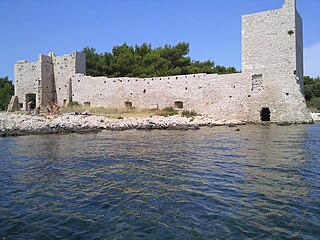
Vir is an island on the Croatian coast of the Adriatic Sea with an area of 22 km2. It lies in Dalmatia, north of the city of Zadar. It is connected to the mainland via a road bridge. The main village on the island is the eponymous village of Vir. There are two more villages, Lozice and Torovi. According to the 2011 census, the island had a population of 3,000 inhabitants, making it the 13th most populous island in Croatia.
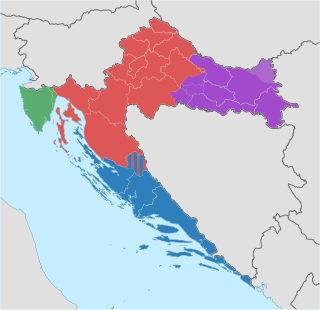
The Republic of Croatia is administratively organised into twenty counties, and is also traditionally divided into four historical and cultural regions: Croatia proper, Dalmatia, Slavonia, and Istria. These are further divided into other, smaller regions.

The counties of Croatia are the primary administrative subdivisions of the Republic of Croatia. Since they were re-established in 1992, Croatia has been divided into 20 counties and the capital city of Zagreb, which has the authority and legal status of both a county and a city. As of 2015, the counties are subdivided into 128 cities and 428 municipalities.

Privlaka is a village in Croatia. It located in eastern Slavonia region, 12 km south of the town of Vinkovci. In the 2001 census, there were 3,776 inhabitants, of which 98.68% Croats.

Municipalities in Croatia are the second lowest administrative unit of government in the country, and along with cities and towns they form the second level of administrative subdisivion, after counties.

The Sopot culture is a neolithic archaeological culture in eastern Slavonia in modern day Croatia. It was a continuation of the Starčevo culture and strongly influenced by the Vinča culture. It spread into northern Bosnia from its original area to the west to northwestern Croatia and to the north to Hungarian Transdanubia, where it helped Lengyel culture start. The culture dates to around 5000 BC. Settlements were raised on the river banks. Houses were square and made of wood using interlace technique, sometimes separated into multiple rooms. Artefacts include many weapons made of bone, flint, obsidian and ironed volcanic rocks and some ceramic pottery of various sizes decorated by carvings or light stabbings and painting.